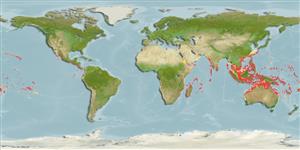Actinopterygii (ray-finned fishes) >
Tetraodontiformes (Puffers and filefishes) >
Diodontidae (Porcupinefishes (burrfishes))
Etymology: Diodon: Greek, di = two + Greek, odous = teeth (Ref. 45335). More on author: Shaw.
Environment / Climate / Range
Ecology
Marine; reef-associated; depth range 1 - 90 m (Ref. 37816), usually 15 - 30 m (Ref. 9680). Tropical, preferred ?; 30°N - 30°S
Indo-Pacific: East Africa to the Society Islands, north to southern Japan, south to New South Wales. Not present in Hawaii (Ref. 9680). Southeast Atlantic: southeast coast of South Africa (Ref. 4423).
Size / Weight / Age
Maturity: Lm ? range ? - ? cm
Max length : 65.0 cm TL male/unsexed; (Ref. 9710)
Inhabits reef edges and slopes (Ref. 6113, 48637). Hides in caves and ledges during the day and forages at night (Ref. 9680). Also found below plate-corals during the day and often deep, ranging to at least 40 meters depth. Juveniles occur in lagoons and estuaries (Ref. 48637). Solitary. Feeds on crustaceans and mollusks. Not usually marketed (Ref. 9680).
Life cycle and mating behavior
Maturity | Reproduction | Spawning | Eggs | Fecundity | Larvae
Myers, R.F., 1991. Micronesian reef fishes. Second Ed. Coral Graphics, Barrigada, Guam. 298 p. (Ref. 1602)
IUCN Red List Status (Ref. 115185)
CITES (Ref. 94142)
Not Evaluated
Threat to humans
Reports of ciguatera poisoning (Ref. 30303)
Human uses
Fisheries: minor commercial; aquarium: commercial
More information
Common namesSynonymsMetabolismPredatorsEcotoxicologyReproductionMaturitySpawningFecundityEggsEgg development
ReferencesAquacultureAquaculture profileStrainsGeneticsAllele frequenciesHeritabilityDiseasesProcessingMass conversion
Tools
Special reports
Download XML
Internet sources
